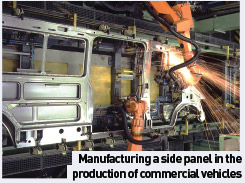The demands of commercial vehicle making are being met with increasingly sophisticated automation software, including integrated Ethernet communication and client/server architectures
Automation faces particular challenges when it comes to the production of commercial vehicles because of the wide variety demanded. Theoretically, the number of variants that might need to be managed can reach 60,000.
Making a finished body-in-white means first producing assemblies such as the underbody or side panels, which then need to be assembled to produce the body-in-white. Due to the large number of possible model-variants, this gives rise to a complex construct that makes high demands of the control and production management systems.
These demands are catered for by a modern automation concept from Schneider Electric that includes:
- Integrated Ethernet communication from production management level down to field level
- Use of client/server architectures for the provision and use of production and facility data, diagnostics, visualization and software tools
- Use of a modern, efficient automation platform.
Trouble-free interworking of all components is required and communication between them is a key element of this. The process control system (PLC) works in close conjunction with the production management system (MES). Within a production cycle, the process, technology and safety PLCs must be perfectly synchronized in order to satisfy the high cycle-time requirements.
These stringent communication requirements are met by the provision of integrated data exchange from production management level down to field level via Ethernet TCP/IP.
Various protocols are used in this context. At PLC and field level, Modbus TCP/IP provides efficient service as an open industrial standard.
For communication with the MES various possibilities exist: apart from Modbus TCP/ IP, further specific application protocols can be implemented based on TCP/Open, so allowing user preferences to be catered to and large data volumes to be transferred with ease.
 In modern bodyshop solutions, client/ server architectures play a major role.
In modern bodyshop solutions, client/ server architectures play a major role.
The advantage of this approach is that data does not have to be filed multiple times throughout the system. Instead, it is filed on distributed servers and accessed from these servers by the various clients. Along with plant and production data, other types of data may be stored there, such as diagnostic data, PLC projects and plant visualization.
No high specifications are required of the client stations, and in extreme cases “thin clients” can be used, which do not even need to be fitted with a hard disk. This procedure can even be used for accessing the various software tools centrally, with a terminal server providing the services of these tools on the client workstations. This considerably simplifies the maintenance of the system as a whole.
The basis of the bodyshop solution presented here is the Unity automation platform from Schneider Electric.
For Unity, the Telemecanique Modicon PLC systems Quantum, Premium and Atrium have been supplemented by high end controllers with specifications that include storage capacities of 8 MB, the shortest program execution times currently available on the market, multi-tasking operating systems and Ethernet and USB as standard interfaces. The Unity Pro software platform is ideally suited to client/server architectures.
Various aspects are already handled as standard: OPC-based data servers, diagnostic functions and the administration of projects and libraries of function blocks and data objects are already integrated. A modern decentralized I/O product family and frequency converters as well as industrial PCs for use with Ethernet round off the whole concept.
This bodyshop solution marks a significant step towards the “digital factory” that is the ultimate strategic goal of motor vehicle manufacturers. IT levels and processes are being increasingly incorporated into this digital factory. The increasing complexity of production plants still remains controllable. Modern control system concepts and transparent, integrated Ethernet based communication architectures contribute substantially to this fact.


































